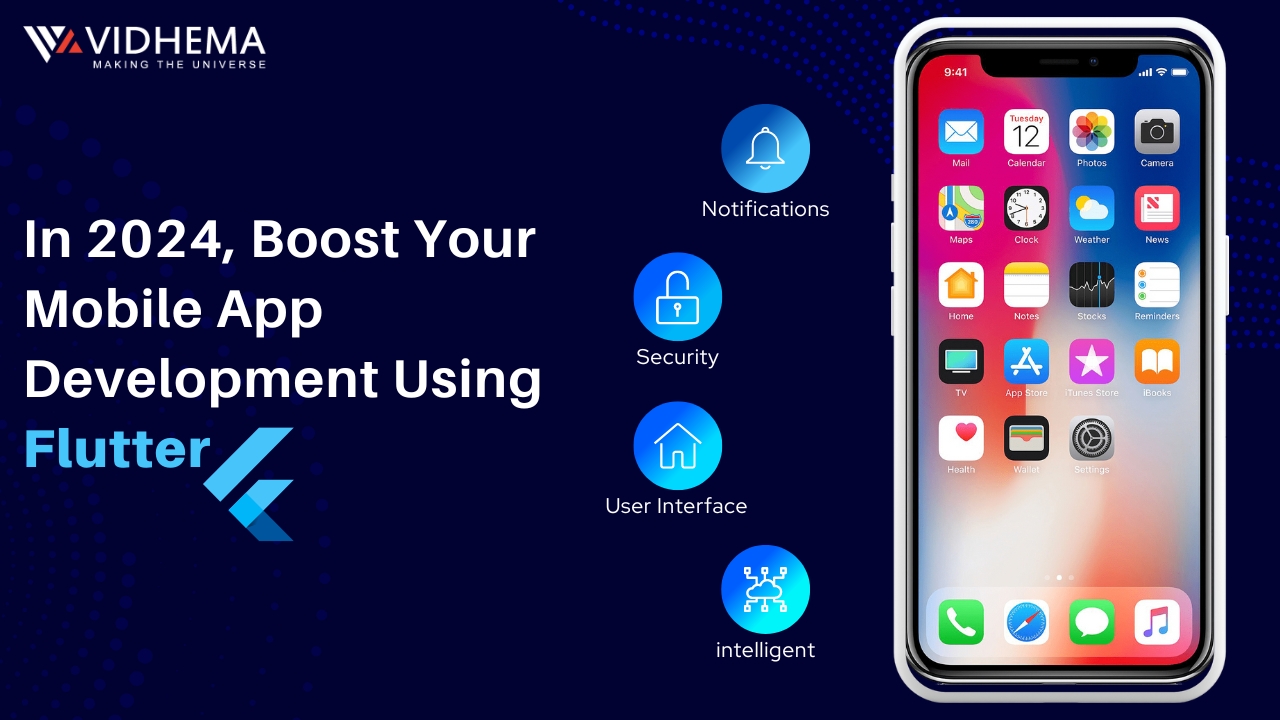
Introduction:
Level-Up Your Mobile App Development With Flutter in 2024
Mobile app development is evolving at an incredible pace, with new tools and technologies emerging regularly. One framework that has consistently stood out in recent years is Flutter, Google's open-source UI toolkit for building natively compiled applications for mobile, web, and desktop from a single codebase. As we step into 2024, Flutter continues to gain momentum, offering developers a versatile and powerful platform to create stunning mobile apps. In this comprehensive guide, we'll explore why Flutter is the go-to choice for mobile app development in 2024 and how you can leverage it to level up your projects.
What is Flutter?
Flutter, released by Google in 2017, is a versatile framework designed to make cross-platform development more accessible and efficient. Using the Dart programming language, Flutter allows developers to write code once and deploy it across multiple platforms, including iOS, Android, Web, and desktop applications. This cross-platform capability has made Flutter a popular choice among developers and businesses looking to streamline the development process and reduce costs.
Key Features of Flutter
1. Hot Reload
One of Flutter's standout features is its hot reload capability. This allows developers to see changes in real-time without restarting the application. Hot reload speeds up the development process by enabling quick iteration and reducing downtime, leading to faster debugging and more efficient coding.
2. Rich Set of Widgets
Flutter offers an extensive collection of pre-designed widgets that can be customized to create unique user interfaces. These widgets follow Google's Material Design guidelines and Apple's Cupertino style, providing developers with the tools to create visually appealing apps that align with platform standards. This wide array of widgets simplifies the process of building complex UIs.
3. Single Codebase for Multiple Platforms
With Flutter, developers can use a single codebase to create apps for multiple platforms. This eliminates the need for separate development teams for iOS and Android, reducing costs and ensuring consistent user experiences across different devices. The ability to share code across platforms also speeds up development timelines.
4. High Performance
Flutter compiles native code, allowing for high-performance applications with smooth animations and transitions. This performance edge makes Flutter a strong choice for apps requiring fast response times and seamless interactions, ensuring a great user experience.
5. Strong Community and Ecosystem
Flutter has a vibrant community and a growing ecosystem of packages and plugins. This community-driven approach ensures that developers have access to a wealth of resources, tutorials, and third-party integrations. The ecosystem includes plugins for common functionalities such as geolocation, camera, and authentication, further accelerating development.
6. Robust Testing and Debugging Tools
Flutter offers robust testing tools to help developers maintain code quality and reliability. From unit tests to widget tests, Flutter provides a comprehensive suite of tools to ensure apps meet high-quality standards. Additionally, Flutter's DevTools offer powerful debugging capabilities, enabling developers to identify and resolve issues quickly.
Why Choose Flutter in 2024?
1. Cross-Platform Development
Flutter's cross-platform capabilities remain a key advantage in 2024. With the mobile app market becoming increasingly competitive, businesses need to deliver consistent experiences across platforms. Flutter's ability to target multiple platforms with a single codebase allows for faster time-to-market and lower development costs.
2. Scalability and Flexibility
Flutter's flexibility makes it suitable for a wide range of applications, from simple mobile apps to complex enterprise solutions. Its scalability ensures that as your project grows, Flutter can adapt to meet your needs. This scalability is crucial for businesses planning for long-term growth.
3. Rapid Prototyping and Development
With features like hot reload and a rich set of widgets, Flutter enables rapid prototyping and development. Developers can quickly create MVPs (Minimum Viable Products) to test concepts and iterate on designs. This agility is invaluable in today's fast-paced development landscape.
4. Consistent User Experience
Flutter's ability to create consistent user experiences across platforms is a significant advantage. By using the same codebase, developers can ensure that users have a seamless experience regardless of whether they're using an iOS or Android device. This consistency enhances brand identity and user satisfaction.
5. Community Support and Growth
Flutter's community continues to grow, with more developers and businesses adopting the framework. This expanding community means that support, resources, and third-party integrations are readily available. As Flutter gains more traction in 2024, developers can expect even more innovations and tools to enhance their development experience.
Getting Started with Flutter
If you're interested in exploring Flutter for mobile app development in 2024, here's a basic guide to getting started:
Step 1: Install Flutter and Dart
To start developing with Flutter, you'll need to install the Flutter SDK and Dart programming language on your system. Follow the official Flutter installation guide for your operating system (Windows, macOS, or Linux).
Step 2: Set Up an IDE
Flutter integrates well with popular integrated development environments (IDEs) like Visual Studio Code and Android Studio. Install your preferred IDE and set up the Flutter and Dart extensions to enable advanced development features and tools.
Step 3: Create a New Flutter Project
Using your IDE, create a new Flutter project and explore the default structure. Experiment with the various widgets and understand how Flutter organizes code.
Step 4: Build and Test
Start building simple applications and utilize Flutter's hot reload feature to see changes in real time. Explore Flutter's testing tools to ensure code quality and reliability.
Step 5: Leverage the Flutter Community
As you develop your skills in Flutter, leverage the community for support and inspiration. Explore online forums, GitHub repositories, and Flutter-related blogs to stay updated with the latest trends and best practices.
Conclusion
Flutter is a dynamic and versatile framework that continues to grow in popularity in 2024. Its cross-platform capabilities, rich set of widgets, high performance, and strong community support make it an excellent choice for mobile app development. By adopting Flutter, you can level up your projects, streamline development processes, and deliver consistent user experiences across platforms. Whether you're a seasoned developer or just starting, Flutter offers the tools and resources to create engaging and high-quality mobile apps.
Frequently Asked Questions
A lot of people don't appreciate the moment until it’s passed. I'm not trying my hardest, and I'm not trying to do
Flutter stands out due to its use of a single codebase to create natively compiled applications for multiple platforms, including iOS, Android, web, and desktop. It offers hot reload for rapid development, a rich set of customizable widgets, and high performance due to native compilation. Additionally, Flutter's strong community and ecosystem provide extensive resources for developers.
Flutter uses Dart, a modern programming language developed by Google. Dart is designed for building scalable, high-performance applications, and it features a simple syntax that's easy to learn for developers familiar with other object-oriented languages like Java or JavaScript.
Yes, Flutter allows you to build applications for both iOS and Android using a single codebase. This cross-platform capability reduces development time and costs by eliminating the need to write separate code for each platform.
Flutter is versatile and can be used for various applications, including:
- Mobile applications for iOS and Android
- Web applications and Progressive Web Apps (PWAs)
- Desktop applications for Windows, macOS, and Linux
- Embedded applications for devices like smart TVs or wearables
Flutter's flexibility makes it suitable for both small projects and large enterprise applications.
Flutter compiles to native code, ensuring that applications run efficiently with smooth animations and transitions. The framework uses a custom rendering engine, Skia, which allows for high-quality graphics and user interfaces. This native compilation process gives Flutter an edge in performance compared to some other cross-platform frameworks that rely on web technologies.
Hot reload is a feature in Flutter that allows developers to see code changes in real-time without restarting the application. This capability significantly speeds up development by enabling rapid iteration, quick debugging, and faster prototyping. Hot reload makes the development process more dynamic and engaging.
Yes, Flutter is suitable for enterprise-level applications. Its ability to scale, combined with robust testing and debugging tools, makes it a strong choice for large-scale projects. Additionally, Flutter's single codebase approach can help enterprises reduce development costs and ensure consistent user experiences across multiple platforms.
To get started with Flutter, you need to:
1. Install the Flutter SDK and Dart on your system.
2. Set up an integrated development environment (IDE) like Visual Studio Code or Android Studio with Flutter and Dart extensions.
3. Create a new Flutter project and explore the basic structure and widgets.
4. Start building simple applications and experiment with Flutter's features, such as hot reload.
5. Leverage the Flutter community for support, tutorials, and resources.
The Flutter community offers extensive support, including online forums, GitHub repositories, and social media groups where developers share their experiences, ask questions, and collaborate. The growing ecosystem provides various third-party packages and plugins that can be integrated into your projects, enhancing functionality and speeding up development.
Flutter can integrate with various backend technologies through RESTful APIs, GraphQL, or WebSockets. You can connect Flutter applications with popular backend frameworks like Firebase, Node.js, Django, Ruby on Rails, and more. This flexibility allows developers to build full-stack applications with Flutter as the frontend and their preferred backend technology for data handling and business logic.

